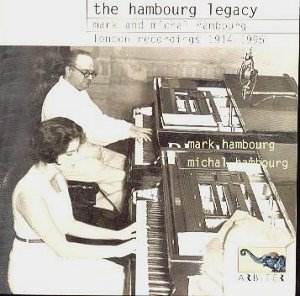AVAILABILITY
www.arbiterrecords.com
Mark Hambourg, Leschetizky pupil, who preceded his
younger compatriot Benno Moiseiwitsch by a year or two in Vienna, made
his first recordings in 1909. As Allan Evans’ notes suggest, his reputation
has long been ambiguous at best and he has never garnered the status
of a Friedman, Rosenthal or indeed a Moiseiwitsch. It is undoubtedly
true that erratic performances have contributed to a less than just
level of esteem – he has one of the most uneven recording legacies of
any top-flight pianist – but it is also true that there are a number
of significant successes amongst those recordings and these include
the recordings he made with his daughter Michal, some of whose recent
1995 private recordings make their appearance in this set as well.
He recorded the Andante spianato (shorn of the Grande
Polonaise) in January 1914. He badly splits a note or two and is very
quick but some of his legato phrasing really is ravishing with the Leschetizky
advice about bel canto (listen to great singers) still clearly uppermost
in Hambourg’s mind. The A flat Beethoven sonata has a good scherzo –
dramatic bass pointing and goodish rhythm – but the funeral march third
movement is not ideally moving or monumental. In the Schumann Andante
and variations Mark is joined by Michal (London, 1933). This is
a free and driving performance that develops a real momentum - even
though the blend between them isn’t always ideal and there are some
slips along the way. The Debussy was arranged by Leonard Borwick, distinguished
British pianist, but in Hambourg’s hands it strangely but obstinately
refuses to come to life, remaining instead rather lacking in fantasy
and a bit heavy. The remainder is devoted to Michal’s performances in
St John’s Wood through 1995. In the Liszt her voicings are good and
she has plenty of imagination for colour and line, even if not always
optimum technique. She also essays the difficult Schumann Fantasie in
C. The first movement produces numerous obstacles and she can be a little
pressurised at moments but it’s not – I hope – ungallant to point out
that she was in her mid-seventies when she recorded these pieces, her
first recordings in fact since 1934. I was concerned that she didn’t
seem to be bringing out the left hand enough in the concluding movement
though is certainly animated enough in that respect later on.
This disc honours the continuing Hambourg legacy with
refinement and generosity and that extends to the documentation. The
two page picture spread in the centre has a couple of unknowns, so let
me tentatively suggest that the bespectacled gentleman on the right
is the jowly Alfred Clark, then head of EMI, and the saturnine cove
with the cigarette looks like Landon Ronald.
Jonathan Woolf

